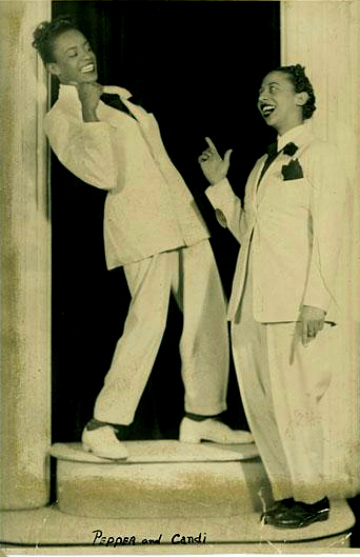Aida Overton Walker
Scene from St. Louis Blues
Hilda Simms
Billie Holiday
Jam Session with Jazz Giants
Cousins
Helen Louise Dillet Johnson
Bessie and the Dancing Sheiks
An Overlooked Blues and Jazz Pioneer
Madam Estelle P Clough
Aurora Greeley
Mamie Emerson
Anise Boyer
Belle Fields: The Black Nightingale
Montrose Sisters
RomeoL Dougherty
Cleo Desmond
Belle Davis
Maude Russell
Aida Ward
Anna Madah Hyers
Hazel Meyers
Lily Yuen
Aida Overton Walker
Della Reese
Bert Williams
Florence Mills
Emma Louise Hyers
Emma Azalia Hackley
Belle Davis
Edith Spencer
Lilyn Brown
Evelyn Preer
Mademoiselle LaLa
Aida Overton Walker
Dorothy at Home
Hyers Sisters
George W Lowther
Sam Marlowe Private Eye
Josephine Baker
Josephine Baker
Josephine Baker
Josephine Baker
Josephine Baker
Josephine Baker
See also...
Authorizations, license
-
Visible by: Everyone -
All rights reserved
-
53 visits
Pepper and Candi


Jewel 'Pepper' Welsh and Mildred 'Candi' Thorpe danced through the 1930s and made their New York debut at the Apollo in September 1941 on a bill that headlined Stump and Stumpy (male tap dancers). Half of the audience consisted of tap dancers 'casing' new acts. "Ladies and Gentlemen, we got two girls who are going to dance for you out of Philadelphia. Candi is sweet, Pepper is hot; come on girls, show me what you got," the emcee announced. "We tore 'em up!" Thorpe remembered. The act opened with a jazz song, such as 'On the Sunny Side of the Street," followed by a rhythm tap solo by Thorpe to 'I've Got Rhythm' played in stop-time, which allowed her to perform her rhythmic breaks without musical accompaniment. Welch followed with her expressive style of flash dancing. Tall and with a beautiful movement style, she added quick turns to her dancing, her jacket flowing from her body. They closed their act to 'One O'clock Jump,' performing trench steps, toe-touching, straddle-split jumps and Russian kazotsky kicks. 'Candi' and 'Pepper' were called back for so many encores by the Apollo audience that they were moved to the closing act, thus gaining the theater's highest billing. The act split up three years later in 1944.
Sources: Frank Driggs Collection; Tap Dancing America: A Cultural History by Constance Valis Hill
Sources: Frank Driggs Collection; Tap Dancing America: A Cultural History by Constance Valis Hill
- Keyboard shortcuts:
Jump to top
RSS feed- Latest comments - Subscribe to the comment feeds of this photo
- ipernity © 2007-2025
- Help & Contact
|
Club news
|
About ipernity
|
History |
ipernity Club & Prices |
Guide of good conduct
Donate | Group guidelines | Privacy policy | Terms of use | Statutes | In memoria -
Facebook
Twitter
